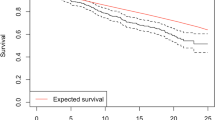Abstract
Purpose
It remains unclear whether the long-term results of RCTs regarding the outcome of microdiscectomy for lumbosacral radicular syndrome (LSRS) are generalizable. The purpose of this study was to determine the external validity of the outcome preseneted in RCTs after microdicectomy for LSRS in a patient cohort from a high-volume spine center.
Methods
Between 2007 and 2010, 539 patients had a single level microdiscectomy for MRI disk-related LSRS of whom 246 agreed to participate. Questionnaires included visual analogue scores (VAS) for leg pain, RDQ, OLBD, RAND-36 and Likert scores for recovery, leg and back pain. Lumbar re-operation(s) were registered.
Results
Mean age was 51.3, and median time of follow-up was 8.0 years. Re-operation occurred in 64 (26%) patients. Unfavorable perceived recovery was noted in 85 (35%) patients, and they had worse leg and back pain than the 161 (65%) patients with a favorable recovery: median VAS for leg pain 28/100 mm versus 2/100 mm and median VAS for back pain 9/100 mm versus 3/100 mm, respectively. In addition, the median RDQ and OLBD scores differed significantly: 9 vs 3 for RDQ and 26 vs 4 for OLBD, respectively (p < 0.001).
Conclusion
In this cohort study, the long-term results after microdiscectomy for LSRS were less favorable than those obtained in RCTs, possibly caused by less strict patient selection than in RCTs. Our findings emphasize that patients, who do not meet the same inclusion criteria for surgery as in RCTs, should be informed about the chances of a less favorable result.

Similar content being viewed by others
References
Lequin MB et al (2013) Surgery versus prolonged conservative treatment for sciatica: 5-year results of a randomised controlled trial. BMJ Open. https://doi.org/10.1136/bmjopen-2012-002534
Overdevest GM et al (2017) Tubular discectomy versus conventional microdiscectomy for the treatment of lumbar disc herniation: long-term results of a randomised controlled trial. J Neurol Neurosurg Psychiatry 88(12):1008–1016
Bailey A et al (2013) Prospective, multicenter, randomized, controlled study of anular repair in lumbar discectomy: two-year follow-up. [Erratum appears in Spine (Phila Pa 1976). 2013 Aug 1;38(17):1527]. Spine 38(14):1161–1169
Thome C et al (2005) Outcome after lumbar sequestrectomy compared with microdiscectomy: a prospective randomized study. J Neurosurg Spine 2(3):271–278
Martin BI et al (2012) Repeat surgery after lumbar decompression for herniated disc: the quality implications of hospital and surgeon variation. Spine J 12(2):89–97
Collins SL, Moore RA, McQuay HJ (1997) The visual analogue pain intensity scale: what is moderate pain in millimetres? Pain 72(1–2):95–97
Patrick DL et al (1995) Assessing health-related quality of life in patients with sciatica. Spine (Phila Pa 1976) 20(17):1899–908 (discussion 1909)
Fairbank JC, Pynsent PB (2000) The oswestry disability index. Spine (Phila Pa 1976) 25(22):2940–52 (discussion 2952)
Brazier JE et al (1992) Validating the SF-36 health survey questionnaire: new outcome measure for primary care. BMJ 305(6846):160–164
Schrimpf D, Haag M, Pilz LR (2014) Possible combinations of electronic data capture and randomization systems. Principles and the realization with RANDI2 and OpenClinica. Methods Inf Med 53(3):202–7
Lurie JD et al (2008) Lumbar discectomy outcomes vary by herniation level in the spine patient outcomes research trial. J Bone Joint Surg - Series A 90(9):1811–1819
Rothwell PM (2005) External validity of randomised controlled trials: “to whom do the results of this trial apply?” Lancet 365(9453):82–93
Weinstein JN et al (2008) Surgical versus nonoperative treatment for lumbar disc herniation: four-year results for the Spine Patient Outcomes Research Trial (SPORT). Spine 33(25):2789–2800
Peul WC et al (2007) Surgery versus prolonged conservative treatment for sciatica. New Engl J Med 356(22):2245–2256
Weinstein JN et al (2006) Surgical vs nonoperative treatment for lumbar disk herniation: the spine patient outcomes research trial (SPORT) observational cohort. J Am Med Assoc 296(20):2451
Atlas SJ et al (2005) Long-term outcomes of surgical and nonsurgical management of sciatica secondary to a lumbar disc herniation: 10 year results from the maine lumbar spine study. Spine 30(8):927–935
Leven D et al (2015) Risk factors for reoperation in patients treated surgically for intervertebral disc herniation: a subanalysis of eight-year sport data. J Bone Joint Surg Am 97(16):1316–1325
Ruetten S et al (2009) Recurrent lumbar disc herniation after conventional discectomy: a prospective, randomized study comparing full-endoscopic interlaminar and transforaminal versus microsurgical revision. J Spin Disord Tech 22(2):122–129
Silvers HR et al (1994) Lumbar diskectomy for recurrent disk herniation. J Spin Disord. https://doi.org/10.1097/00002517-199410000-00007
Fritsch EW, Heisel J, Rupp S (1996) The failed back surgery syndrome: reasons, intraoperative findings, and long-term results: a report of 182 operative treatments. Spine 21(5):626–633
Martin BI et al (2007) Reoperation rates following lumbar spine surgery and the influence of spinal fusion procedures. Spine (Phila Pa 1976) 32(3):382–7
Bailey CS et al (2020) Surgery versus conservative care for persistent sciatica lasting 4 to 12 months. N Engl J Med 382(12):1093–1102
Morton SM et al (2012) In the 21st century, what is an acceptable response rate? Aust N Z J Public Health 36(2):106–108
Funding
None.
Author information
Authors and Affiliations
Corresponding author
Ethics declarations
Conflict of interest
None.
Additional information
Publisher's Note
Springer Nature remains neutral with regard to jurisdictional claims in published maps and institutional affiliations.
Rights and permissions
About this article
Cite this article
Lequin, M., Verbaan, D., Schuurman, P.R. et al. Microdiscectomy for sciatica: reality check study of long-term surgical treatment effects of a Lumbosacral radicular syndrome (LSRS). Eur Spine J 31, 400–407 (2022). https://doi.org/10.1007/s00586-021-07074-x
Received:
Revised:
Accepted:
Published:
Issue Date:
DOI: https://doi.org/10.1007/s00586-021-07074-x




